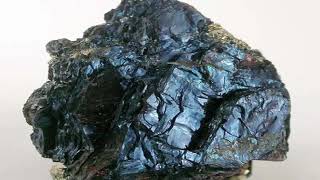معلومات عن الحجرالكريم الكوفيليت Covellite
معلومات عن الحجرالكريم الكوفيليت Covellite

التركيب الكيميائي كبرتيد النحاسيك نحاس 66.4% كبريت 33.6% قد يحتوي على الحديد.Covellite (also known as covelline) is a rare copper sulfide mineral with the formula CuS.[3] This indigo blue mineral is commonly a secondary mineral in limited abundance and although it is not an important ore of copper itself, it is well known to mineral collectors.[3]
The mineral is generally found in zones of secondary enrichment (supergene) of copper sulfide deposits. Commonly found as coatings on chalcocite, chalcopyrite, bornite, enargite, pyrite, and other sulfides, it often occurs as pseudomorphic replacements of other minerals.[4] The first records are from Mount Vesuvius, formally named in 1832 after N. Covelli.[3] Research of its unique properties has only surged in past decade yet promising results suggest may be used widescale in certain specific applications in the future.
Contents
1 Composition
2 Structure
3 Formation
3.1 Naturally occurring
3.2 Synthetic
4 Occurrence
5 Applications
5.1 Superconductors
5.2 Lithium ion batteries
5.3 Nanostructures
6 See also
7 References
Composition
Covellite belongs to the binary copper sulfides group, which has the formula CuxSy and can have a wide-ranging copper/sulfur ratio, from 1:2 to 2:1 (Cu/S). However, this series is by no means continuous and the homogeneity range of covellite CuS is narrow. Materials rich in sulfur CuSx where x~ 1.1- 1.2 do exist, but they exhibit “superstructures”, a modulation of the hexagonal ground plane of the structure spanning a number of adjacent unit cells.[5] This indicates that several of covellite’s special properties are the result of molecular structure at this level.
As described for copper monosulfides like pyrite, the assignment of formal oxidation states to the atoms that constitute covellite is deceptive.[6] The formula might seem to suggest the description Cu2+, S2−. In fact the atomic structure shows that copper and sulfur each adopt two different geometries. However photoelectron spectroscopy, magnetic, and electrical properties all indicate the absence of Cu2+ (d9) ions.[6] In contrast to the oxide CuO, the material is not a magnetic semiconductor but a metallic conductor with weak Pauli-paramagnetism.[7] Thus, the mineral is better described as consisting of Cu+ and S− rather than Cu2+ and S2−. Compared to pyrite with a non-closed shell of S− pairing to form S22−, there are only 2/3 of the sulfur atoms held.[6] The other 1/3 remains unpaired and together with Cu atoms forms hexagonal layers reminiscent of the boron nitride (graphite structure).[6] Thus, a description Cu+3S−S22− would seem appropriate with a delocalized hole in the valence band leading to metallic conductivity. Subsequent band structure calculations indicate however that the hole is more localized on the sulfur pairs than on the unpaired sulfur. This means that Cu+3S2−S2− with a mixed sulfur oxidation state -2 and -1/2 is more appropriate. Despite the extended formula of Cu+3S2−S2− from researchers in 1976 and 1993, others have come up with variations, such as Cu+4Cu2+2(S2)2S2.[8]
